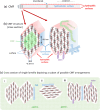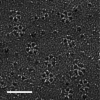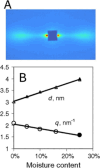How Many Glucan Chains Form Plant Cellulose Microfibrils? A Mini Review
- PMID: 39207939
- PMCID: PMC11480985
- DOI: 10.1021/acs.biomac.4c00995
How Many Glucan Chains Form Plant Cellulose Microfibrils? A Mini Review
Abstract
Assessing the number of glucan chains in cellulose microfibrils (CMFs) is crucial for understanding their structure-property relationships and interactions within plant cell walls. This Review examines the conclusions and limitations of the major experimental techniques that have provided insights into this question. Small-angle X-ray and neutron scattering data predominantly support an 18-chain model, although analysis is complicated by factors such as fibril coalescence and matrix polysaccharide associations. Solid-state nuclear magnetic resonance (NMR) spectroscopy allows the estimation of the CMF width from the ratio of interior to surface glucose residues. However, there is uncertainty in the assignment of NMR spectral peaks to surface or interior chains. Freeze-fracture transmission electron microscopy images show cellulose synthase complexes to be "rosettes" of six lobes each consistent with a trimer of cellulose synthase enzymes, consistent with the synthesis of 18 parallel glucan chains in the CMF. Nevertheless, the number of chains in CMFs remains to be conclusively demonstrated.
Conflict of interest statement
The authors declare no competing financial interest.
Figures






Similar articles
-
Wide-angle x-ray scattering and solid-state nuclear magnetic resonance data combined to test models for cellulose microfibrils in mung bean cell walls.Plant Physiol. 2013 Dec;163(4):1558-67. doi: 10.1104/pp.113.228262. Epub 2013 Oct 23. Plant Physiol. 2013. PMID: 24154621 Free PMC article.
-
Texture of cellulose microfibrils of root hair cell walls of Arabidopsis thaliana, Medicago truncatula, and Vicia sativa.J Microsc. 2012 Jul;247(1):60-7. doi: 10.1111/j.1365-2818.2012.03611.x. Epub 2012 Mar 28. J Microsc. 2012. PMID: 22458271
-
Cellulose microfibril crystallinity is reduced by mutating C-terminal transmembrane region residues CESA1A903V and CESA3T942I of cellulose synthase.Proc Natl Acad Sci U S A. 2012 Mar 13;109(11):4098-103. doi: 10.1073/pnas.1200352109. Epub 2012 Feb 28. Proc Natl Acad Sci U S A. 2012. PMID: 22375033 Free PMC article.
-
Solid-state NMR investigations of cellulose structure and interactions with matrix polysaccharides in plant primary cell walls.J Exp Bot. 2016 Jan;67(2):503-14. doi: 10.1093/jxb/erv416. Epub 2015 Sep 9. J Exp Bot. 2016. PMID: 26355148 Free PMC article. Review.
-
Cellulose microfibrils in plants: biosynthesis, deposition, and integration into the cell wall.Int Rev Cytol. 2000;199:161-99. doi: 10.1016/s0074-7696(00)99004-1. Int Rev Cytol. 2000. PMID: 10874579 Review.
Cited by
-
Uniform elementary fibrils in diverse plant cell walls.Proc Natl Acad Sci U S A. 2025 Apr 15;122(15):e2426467122. doi: 10.1073/pnas.2426467122. Epub 2025 Apr 7. Proc Natl Acad Sci U S A. 2025. PMID: 40193604
-
An alternate route for cellulose microfibril biosynthesis in plants.Sci Adv. 2024 Dec 13;10(50):eadr5188. doi: 10.1126/sciadv.adr5188. Epub 2024 Dec 13. Sci Adv. 2024. PMID: 39671498 Free PMC article.
-
Structure, function and assembly of soybean primary cell wall cellulose synthases.Elife. 2025 May 14;13:RP96704. doi: 10.7554/eLife.96704. Elife. 2025. PMID: 40365874 Free PMC article.
-
Solid-state NMR at natural isotopic abundance for bioenergy applications.Biotechnol Biofuels Bioprod. 2025 Apr 28;18(1):46. doi: 10.1186/s13068-025-02648-z. Biotechnol Biofuels Bioprod. 2025. PMID: 40296123 Free PMC article. Review.
-
Empirical evidence that glucan-interacting amino acid side chains within the transmembrane channel collectively facilitate cellulose synthase function.Plant Mol Biol. 2025 Jul 9;115(4):85. doi: 10.1007/s11103-025-01615-4. Plant Mol Biol. 2025. PMID: 40632364 Free PMC article.
References
-
- Nishiyama Y. Structure and properties of the cellulose microfibril. J. Wood Sci. 2009, 55, 241–9. 10.1007/s10086-009-1029-1. - DOI
Publication types
MeSH terms
Substances
LinkOut - more resources
Full Text Sources

